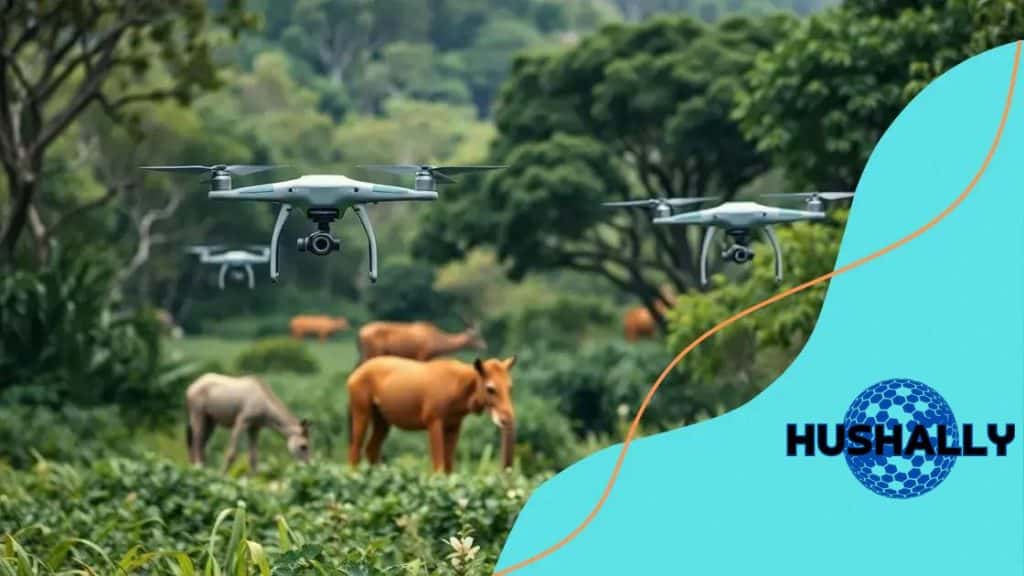AI in wildlife conservation efforts: a game changer

AI in wildlife conservation efforts enhances monitoring and protection by analyzing vast data sets, improving accuracy, and enabling predictive analytics, ultimately leading to better decision-making for preserving endangered species.
AI in wildlife conservation efforts has become a crucial tool for protecting endangered species and preserving biodiversity. Curious about how technology merges with nature preservation? Let’s dive into its impact.
How AI is transforming wildlife monitoring
Artificial Intelligence (AI) is changing the way we monitor wildlife, making it faster and more efficient. Traditional methods of tracking animal populations can be time-consuming and often inaccurate. However, with the integration of AI, conservationists can gather valuable data on animal behavior, migration patterns, and habitat use with greater precision.
AI algorithms analyze vast amounts of data collected from various sources, including drones, camera traps, and satellite imagery. This technology allows researchers to identify species more accurately and monitor their health and numbers.
Benefits of AI in wildlife monitoring
Some key benefits of using AI for wildlife monitoring include:
- Efficiency: Machine learning models can process data much faster than humans, saving time for researchers.
- Accuracy: AI helps in reducing human error, leading to more reliable data.
- Real-time insights: Conservationists receive immediate feedback about wildlife activity, essential for timely interventions.
This technological revolution significantly enhances our ability to study and protect endangered species. For instance, AI can predict where certain animals will be based on environmental changes, allowing for proactive conservation efforts.
As these tools become more accessible, we can expect an increase in collaborative efforts between tech companies and wildlife organizations. Together, they can create innovative solutions that contribute to effective conservation strategies.
Challenges faced with AI technology
Despite its advantages, implementing AI in wildlife monitoring does present challenges. Issues such as data privacy, potential bias in algorithms, and the need for extensive training data must be addressed.
Moreover, integrating these systems into existing conservation practices requires adaptive strategies. Collaboration among wildlife experts, technologists, and policymakers is crucial to maximize the impact of AI in this field.
By overcoming these challenges, wildlife monitoring can become an even more powerful tool in the fight to preserve our planet’s biodiversity. It’s an exciting time for conservation, with AI leading the way to more effective monitoring solutions.
Benefits of AI in species protection
Artificial Intelligence (AI) brings numerous benefits to species protection, revolutionizing how organizations approach conservation efforts. By analyzing large datasets, AI can reveal important insights about endangered species.
One primary advantage of using AI is improved accuracy in tracking animal populations. Traditional methods can sometimes lead to errors, but AI algorithms can enhance precision, ensuring that conservationists have reliable data.
Enhanced data collection
AI technologies assist in gathering information from various sources, including camera traps and satellite imagery. The ability to process this data quickly allows for:
- Rapid analysis: Getting timely insights into wildlife movements and behaviors.
- Detection of patterns: Understanding migration paths and breeding habits.
- Resource allocation: Directing efforts where they are most needed based on data findings.
These advancements pave the way for proactive approaches in conservation. By predicting potential threats to habitats or populations, AI empowers organizations to act before crises arise.
Another benefit of AI is its ability to minimize human intervention in sensitive areas. With drones equipped with AI, conservationists can monitor wildlife without disturbing their natural behavior, ensuring more accurate assessments of animal health and population dynamics.
Cost-effective solutions
Implementing AI in species protection often leads to more cost-effective conservation strategies. These include:
- Reduction in manpower: Automating monitoring processes decreases the need for extensive field teams.
- Long-term savings: Better information management can lower operational costs related to conservation.
- Increased funding opportunities: Successful AI initiatives can attract additional resources for important projects.
As we embrace the advantages of AI in species protection, we open new avenues for preserving biodiversity. The synergy of technology and conservation offers hope for endangered species and the ecosystems they inhabit.
Challenges of integrating AI in conservation efforts

Integrating Artificial Intelligence (AI) into conservation efforts presents several challenges, despite its many advantages. These hurdles can be complex and multifaceted. Addressing them is crucial for the successful adoption of this technology in protecting wildlife and their habitats.
One major challenge is the data quality. AI algorithms rely heavily on large datasets to learn and make predictions. If the data is biased or flawed, the outcomes can be misleading. This can lead to incorrect assessments about species and their needs.
Data Privacy Concerns
Another significant challenge involves data privacy. Wildlife monitoring often includes sensitive information about habitats and species. Ensuring this data remains secure is vital, as breaches could severely affect conservation initiatives. Conservationists must balance privacy needs with the requirement for data sharing among researchers and organizations.
The technical expertise required to implement AI solutions is another barrier. Many conservation organizations may lack the necessary skills and resources to develop and manage these advanced technologies. This gap can slow down progress and inhibit the effectiveness of AI in the field.
Cost Implications
Integrating AI also involves financial challenges. While AI can save costs in the long run, the initial investment can be significant. Many smaller organizations may struggle to allocate funds for new technology, making it hard to adopt AI-driven methods.
- High initial costs: Investing in technology, training, and infrastructure can be overwhelming.
- Long-term commitment: Organizations need to commit resources over time to see the full benefits of AI.
- Funding challenges: Securing grants and funds for AI initiatives requires clear proposals and potential outcomes.
Moreover, adapting AI technology to unique ecological contexts can be challenging. What works in one ecosystem may not be effective in another, requiring ongoing adjustments and local expertise. This makes it essential for conservationists to collaborate with technologists and local communities to create tailored solutions.
As we move forward, addressing these challenges will be key to unlocking the full potential of AI in conservation efforts. Collaboration, training, and reliable data will play vital roles in overcoming these barriers.
Successful case studies of AI in wildlife conservation
Many successful case studies showcase how Artificial Intelligence (AI) has played a vital role in wildlife conservation. These examples demonstrate the practical applications and potential of AI technology in protecting endangered species and their habitats.
One remarkable case is the use of AI in monitoring the populations of the African elephant. Conservationists are deploying AI algorithms analyzed from camera trap images. This approach helps identify individual elephants and track their movements precisely. Such monitoring aids in preventing poaching and ensuring a stable population.
Monitoring Marine Species
Another inspiring case involves marine life, particularly the monitoring of the great whale population. Advanced AI systems analyze acoustic data to detect whale calls. This provides valuable insights into whale behaviors and migration patterns. With real-time information, marine biologists can make informed decisions to respond to threats.
In another study, AI has been used to combat illegal fishing. By employing machine learning algorithms, researchers analyze satellite imagery to identify fishing activities in protected areas. This technology helps authorities intervene more quickly to protect overfished species.
Enhancing Species Recovery
AI is also playing a critical role in species recovery efforts. For example, the California condor, once on the brink of extinction, saw improvements thanks to AI-driven population modeling. Conservationists used this data to make strategic decisions about breeding programs and habitat restoration.
- Predictive analytics: Using AI models, experts can forecast future population sizes and plan conservation efforts accordingly.
- Habitat mapping: AI helps in identifying and mapping critical habitats, ensuring that conservation initiatives target the right areas.
- Community engagement: Successful cases often involve local communities, leveraging AI to educate and involve them in conservation efforts.
These case studies illustrate that the partnership between technology and conservation can yield remarkable results. The potential of AI in wildlife conservation is only beginning to be tapped, paving the way for innovative solutions to protect our planet’s biodiversity.
The future of AI in environmental protection
The future of Artificial Intelligence (AI) in environmental protection looks promising and transformative. As technology continues to advance, AI will play an even more significant role in addressing critical environmental challenges.
One key aspect will be the enhanced use of AI in data analysis. With the growing amounts of environmental data collected from satellites, sensors, and drones, AI can help synthesize and interpret this information quickly. This accelerated processing will lead to better-informed decisions for conservation and sustainable practices.
Predictive Analytics
Predictive analytics, powered by AI, offers a way to foresee environmental issues before they escalate. By analyzing historical data and current trends, AI can forecast events like natural disasters or species declines. This proactive approach will empower organizations to implement timely interventions.
AI can also enhance climate modeling. By simulating various scenarios, it helps scientists understand the potential impacts of climate change on ecosystems. This knowledge is crucial for developing effective strategies to mitigate negative effects and promote resilience.
Smart Resource Management
In the future, smart resource management will benefit greatly from AI technologies. For example, AI can optimize energy consumption in buildings and monitor water usage in agriculture. These advancements will lead to more efficient use of resources and reduce waste, contributing to environmental sustainability.
- Eco-friendly solutions: AI can facilitate the development of green technologies and renewable energy systems.
- Improved conservation efforts: AI systems can help track endangered species and ensure their habitats are protected.
- Community engagement: Using AI tools, local communities can participate in monitoring and protecting their environments.
As we look ahead, the collaboration between policymakers, researchers, and technologists will be essential for harnessing the full power of AI in environmental protection. Continuous investment in research and education will also ensure that future generations are well-equipped to tackle these challenges. The ongoing integration of AI in our environmental practices holds the potential to create a healthier planet for all.
The integration of Artificial Intelligence (AI) in environmental protection marks an exciting frontier in conservation efforts. AI can significantly enhance our ability to monitor and protect wildlife while promoting sustainability. Through real-time data analysis and predictive modeling, we can better understand our ecosystems and make informed decisions. As technology evolves, collaboration among experts will be vital to unlock the potential of AI. By embracing these innovations, we can create a healthier planet for future generations and ensure that our environment thrives.
FAQ – Frequently Asked Questions about AI in Wildlife Conservation
How does AI help in wildlife monitoring?
AI analyzes data from various sources, like camera traps and drones, to track animal populations and behaviors accurately.
What are the benefits of using AI in conservation efforts?
AI improves data accuracy, enhances real-time monitoring, and enables predictive analytics for better decision-making.
Are there any challenges in implementing AI for conservation?
Yes, challenges include data quality, cost, and the need for technical expertise.
What does the future hold for AI in environmental protection?
The future includes better predictive models, smarter resource management, and collaborative efforts to harness technology for sustainability.





